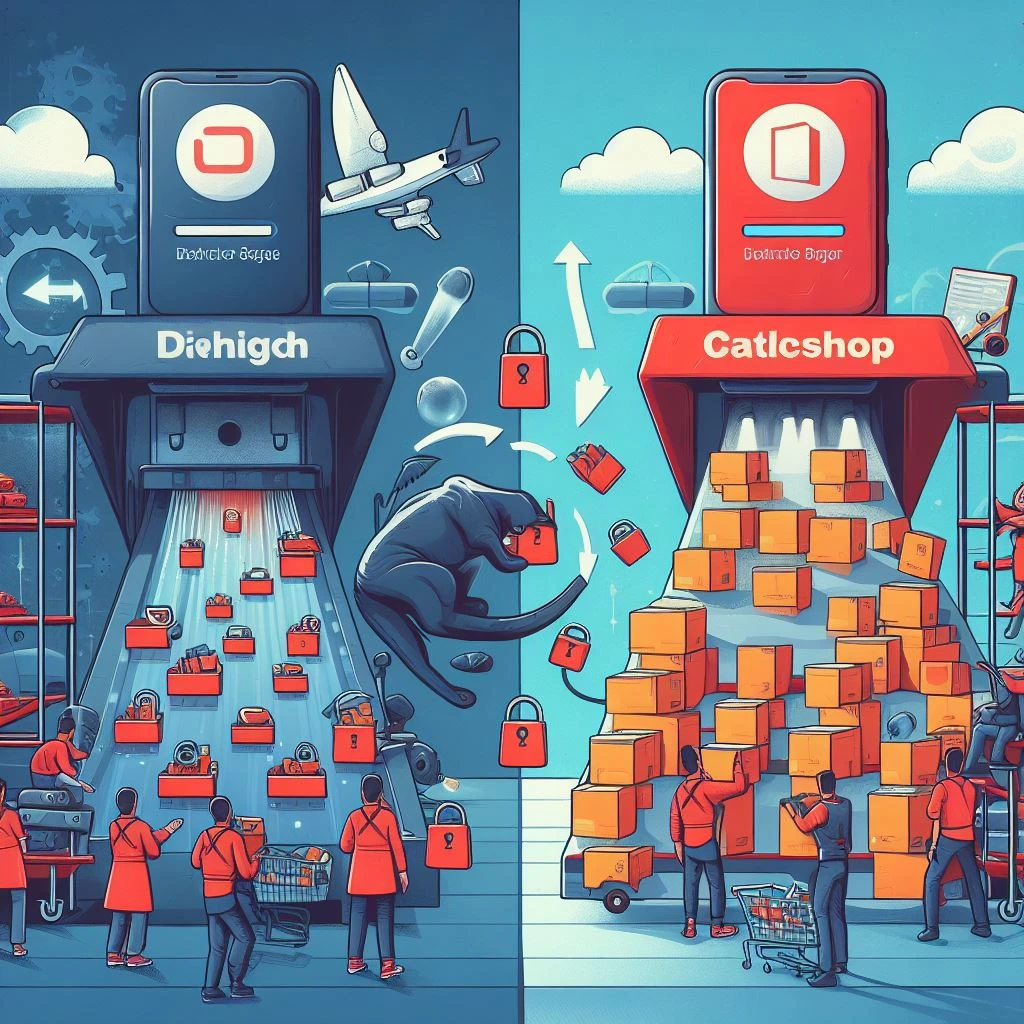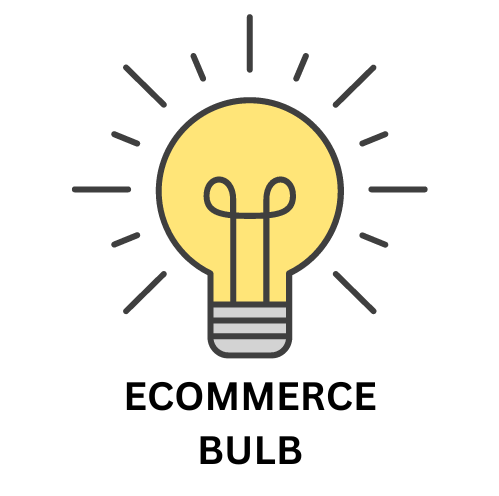In order to decide which ecommerce platform to use, BigCommerce vs Adobe Commerce (Formerly Magento). A detailed comparison between features must be thoroughly done. If you want to decide which eCommerce platform to choose, there are many things to consider.
These are some examples of these factors:
- Cost.
- SEO friendliness.
- Page load speed.
- Canonical website URL.
- Indexing Control.
- Customizable HTML capabilities.
- Sitemap Generator.
- Integration with Google Analytics.
- Product Tagging and Categorization.
- Batch Uploading.
- Mobile Optimization.
- Built-in Blogging and Marketing Features.
- Social Sharing Buttons.
- Content Management Capabilities.
- Discount and promotion code tools.
- Easy to use Checkout.
- Reporting tools and custom reports.
- Integration of email marketing tools.
- Multiple payment options.
- Flexibility to add new eCommerce features.
- Exclusive features.
- Cons and pros.
Here we’ll discuss these factors to help you decide which platform is better for you, Adobe Commerce or BigCommerce. And at the end of the discussion, we’ll recap and make a comparison for the scores of all these points to find out which eCommerce platform has the higher score, so that you’ll have a good view about both of them.
Pricing (BigCommerce vs Adobe Commerce):

BigCommerce vs Adobe Commerce cost
Here is a pricing tiers comparison summary and table of BigCommerce vs Adobe Commerce:
Pricing Tiers Comparison Summary
| Feature | BigCommerce | Adobe Commerce |
|---|---|---|
| Pricing model | Subscription-based | Custom quote |
| Pricing tiers | 4 | Varies |
| Starting price | $30/month | Custom quote |
| Target businesses | Small to medium-sized businesses | Large enterprises |
Pricing Tiers Comparison Table
| BigCommerce Tier | Annual Revenue | Price | Features |
|---|---|---|---|
| Essential | $0 – $50,000 | $30/month | Basic eCommerce features |
| Plus | $50,000 – $150,000 | $79/month | Additional eCommerce features |
| Premium | $150,000 – $300,000 | $199/month | Advanced eCommerce features |
| Enterprise | $300,000+ | Custom quote | Scalable eCommerce platform |
Adobe Commerce
Adobe Commerce offers custom pricing based on the needs of each business. Factors that can affect pricing include:
- Annual revenue
- Online sales volume
- Number of products
- Number of users
- Features required
Adobe Commerce is generally a more expensive platform than BigCommerce, but it is also more scalable and customizable. It is a good option for large enterprises that need a powerful and flexible eCommerce platform.
Overall, BigCommerce is a good option for small to medium-sized businesses that are looking for an affordable and easy-to-use eCommerce platform. Adobe Commerce is a better option for large enterprises that need a powerful and scalable eCommerce platform.
SEO Capabilities (BigCommerce vs Adobe Commerce):

Here is a summary and comparison table of the SEO capabilities of BigCommerce and Adobe Commerce:
SEO Capabilities Summary
Both BigCommerce and Adobe Commerce offer a variety of built-in SEO features to help you improve your website’s search engine ranking. However, Adobe Commerce offers a wider range of advanced SEO features that may be more beneficial for larger businesses with complex SEO needs.
BigCommerce SEO Features
- Search engine friendly URLs: BigCommerce automatically generates search engine friendly URLs for your products and categories.
- Meta titles and descriptions: You can easily add meta titles and descriptions to your products and categories.
- Image optimization: BigCommerce automatically optimizes your product images for search engines.
- Sitemap generation: BigCommerce automatically generates a sitemap for your website.
- Structured data markup: BigCommerce supports structured data markup, which can help search engines understand your website’s content.
Adobe Commerce SEO Features
- All of the BigCommerce SEO features, plus:
- Advanced URL management: More control over your product and category URLs.
- Canonical tags: Canonical tags help search engines identify the original version of a page.
- Hreflang tags: Hreflang tags help search engines identify different language versions of your website.
- Rich snippets: Rich snippets provide more information about your products and categories in search results.
- Page speed optimization: Adobe Commerce includes tools to help you optimize your website’s page speed.
SEO Capabilities Comparison Table
| Feature | BigCommerce | Adobe Commerce |
|---|---|---|
| Search engine friendly URLs | Yes | Yes |
| Meta titles and descriptions | Yes | Yes |
| Image optimization | Yes | Yes |
| Sitemap generation | Yes | Yes |
| Structured data markup | Yes | Yes |
| Advanced URL management | No | Yes |
| Canonical tags | No | Yes |
| Hreflang tags | No | Yes |
| Rich snippets | No | Yes |
| Page speed optimization | Limited | Yes |
Overall, Adobe Commerce offers a more comprehensive suite of SEO features than BigCommerce. However, BigCommerce’s SEO features are still very good and may be sufficient for the needs of many businesses.
PageLoad Speed (BigCommerce vs Adobe Commerce):

Magento vs BigCommerce Review – PageLoad Speed summary and comparison table (BigCommerce vs Adobe Commerce)
Here is a comparison of BigCommerce and Adobe Commerce in terms of page load speed:
Page Load Speed Summary
Both BigCommerce and Adobe Commerce offer features to help improve page load speed. However, Adobe Commerce generally outperforms BigCommerce in terms of page load speed. This is due to a number of factors, including:
- Adobe Commerce’s use of a more powerful content delivery network (CDN)
- Adobe Commerce’s ability to cache static content
- Adobe Commerce’s use of more efficient code
BigCommerce Page Load Speed Features
- Built-in image optimization: BigCommerce automatically optimizes your product images for faster loading.
- Lazy loading: BigCommerce only loads images when they are needed, which can improve page load speed.
- Minification: BigCommerce minifies CSS, JavaScript, and HTML files, which can reduce their size and improve page load speed.
Adobe Commerce Page Load Speed Features
- All of the BigCommerce page load speed features, plus:
- A more powerful CDN: Adobe Commerce uses a CDN that is distributed across multiple servers around the world, which can reduce latency and improve page load speed.
- Caching of static content: Adobe Commerce caches static content, such as images and CSS files, which can reduce the need to fetch these files from the server, which can improve page load speed.
- Use of more efficient code: Adobe Commerce uses more efficient code, which can reduce the amount of time it takes for pages to render.
Page Load Speed Comparison Table
| Feature | BigCommerce | Adobe Commerce |
|---|---|---|
| Built-in image optimization | Yes | Yes |
| Lazy loading | Yes | Yes |
| Minification | Yes | Yes |
| CDN | Standard | Premium |
| Caching of static content | Limited | Extensive |
| Use of efficient code | Good | Excellent |
Overall, Adobe Commerce offers a more comprehensive suite of page load speed features than BigCommerce. However, BigCommerce’s page load speed features are still very good and may be sufficient for the needs of many businesses.
Canonical Website URL (BigCommerce vs Adobe Commerce):

BigCommerce vs Adobe Commerce pros and cons –
Canonical Website URL capabilities summary and comparison table
(BigCommerce vs Adobe Commerce)
Here is a comparison of BigCommerce and Adobe Commerce in terms of canonical URL capabilities:
Canonical Website URL Capabilities Summary
Both BigCommerce and Adobe Commerce allow you to specify canonical URLs for your website pages. This is important for SEO, as it tells search engines which page is the original version of a page and which pages are duplicates.
BigCommerce Canonical URL Capabilities
- You can specify a canonical URL for each page of your website.
- BigCommerce automatically generates canonical URLs for product and category pages.
- You can use the BigCommerce plugin to automatically generate canonical URLs for other types of pages.
Adobe Commerce Canonical URL Capabilities
- All of the BigCommerce canonical URL capabilities, plus:
- More granular control over canonical URLs.
- The ability to specify canonical URLs for individual products and categories.
- The ability to use canonical URLs to prevent content scraping.
Canonical Website URL Capabilities Comparison Table
| Feature | BigCommerce | Adobe Commerce |
|---|---|---|
| Canonical URLs for all pages | Yes | Yes |
| Automatic canonical URLs for product and category pages | Yes | Yes |
| Automatic canonical URLs for other types of pages | Plugin required | Yes |
| Granular control over canonical URLs | Limited | Extensive |
| Canonical URLs for individual products and categories | No | Yes |
| Canonical URLs to prevent content scraping | No | Yes |
Overall, Adobe Commerce offers a more comprehensive suite of canonical URL capabilities than BigCommerce. However, BigCommerce’s canonical URL capabilities are still very good and may be sufficient for the needs of many businesses.
Indexing Control (BigCommerce vs Adobe Commerce):

Indexing Control capabilities summary & comarison table (BigCommerce vs Adobe Commerce)
Here is a comparison of BigCommerce and Adobe Commerce in terms of indexing control capabilities:
Indexing Control Capabilities Summary
Both BigCommerce and Adobe Commerce offer features to help you control how your website is indexed by search engines. However, Adobe Commerce generally offers more control over indexing than BigCommerce. This is due to a number of factors, including:
- Adobe Commerce’s ability to set noindex and nofollow tags at the page level
- Adobe Commerce’s ability to create custom robots.txt files
- Adobe Commerce’s ability to use structured data to control how search engines index your website
BigCommerce Indexing Control Features
- Meta robots tags: You can add meta robots tags to your pages to control whether they are indexed by search engines.
- XML sitemap: BigCommerce automatically generates an XML sitemap for your website, which can help search engines discover your pages.
- URL filtering: You can filter which URLs are included in your XML sitemap.
Adobe Commerce Indexing Control Features
- All of the BigCommerce indexing control features, plus:
- Noindex and nofollow tags: You can set noindex and nofollow tags at the page level to prevent search engines from indexing or following links on a page.
- Custom robots.txt files: You can create custom robots.txt files to control how search engines crawl your website.
- Structured data: You can use structured data to control how search engines index your website, such as by providing information about your products, categories, and authors.
Indexing Control Comparison Table
| Feature | BigCommerce | Adobe Commerce |
|---|---|---|
| Meta robots tags | Yes | Yes |
| XML sitemap | Yes | Yes |
| URL filtering | Yes | Yes |
| Noindex and nofollow tags | Page-level | Page-level |
| Custom robots.txt files | No | Yes |
| Structured data | Limited | Extensive |
Overall, Adobe Commerce offers a more comprehensive suite of indexing control features than BigCommerce. However, BigCommerce’s indexing control features are still very good and may be sufficient for the needs of many businesses.
Customizable HTML Capabilities (BigCommerce vs Adobe Commerce):

Sure, here is a comparison of BigCommerce and Adobe Commerce in terms of customizable HTML capabilities:
Customizable HTML Capabilities Summary
Both BigCommerce and Adobe Commerce allow you to customize the HTML of your website pages. However, Adobe Commerce offers more flexibility and control over HTML customization than BigCommerce. This is due to a number of factors, including:
- Adobe Commerce’s ability to edit HTML templates
- Adobe Commerce’s ability to create custom themes
- Adobe Commerce’s ability to use third-party code
BigCommerce Customizable HTML Capabilities
- You can edit the HTML of your website pages using the BigCommerce theme editor.
- You can use BigCommerce’s stencil system to create custom themes.
- You can add third-party code to your website using BigCommerce’s extensions system.
Adobe Commerce Customizable HTML Capabilities
- All of the BigCommerce customizable HTML capabilities, plus:
- Direct access to HTML templates: You can directly edit the HTML templates for your website pages.
- Greater flexibility with custom themes: You have more flexibility when creating custom themes for your website.
- Support for third-party code: You can use third-party code to extend the functionality of your website.
Customizable HTML Capabilities Comparison Table
| Feature | BigCommerce | Adobe Commerce |
|---|---|---|
| HTML editing | Theme editor | Template editing |
| Custom themes | Stencil system | More flexible theme customization |
| Third-party code | Extensions system | Direct code integration |
Overall, Adobe Commerce offers a more comprehensive suite of customizable HTML capabilities than BigCommerce. However, BigCommerce’s customizable HTML capabilities are still very good and may be sufficient for the needs of many businesses.
Sitemap Generators (BigCommerce vs Adobe Commerce):

Here is a comparison of BigCommerce and Adobe Commerce in terms of sitemap generator capabilities:
Sitemap Generators Capabilities Summary
Both BigCommerce and Adobe Commerce offer built-in sitemap generators to help you create and submit sitemaps to search engines. However, Adobe Commerce offers more advanced sitemap generation features than BigCommerce.
BigCommerce Sitemap Generator Features
- Automatically generates an XML sitemap for your website.
- Allows you to filter which URLs are included in your sitemap.
- Provides a preview of your sitemap.
Adobe Commerce Sitemap Generator Features
- All of the BigCommerce sitemap generator features, plus:
- Supports multiple sitemaps for large websites.
- Allows you to prioritize URLs in your sitemap.
- Provides detailed sitemap analytics.
Sitemap Generator Comparison Table
| Feature | BigCommerce | Adobe Commerce |
|---|---|---|
| Automatic sitemap generation | Yes | Yes |
| URL filtering | Yes | Yes |
| Sitemap preview | Yes | Yes |
| Multiple sitemaps | No | Yes |
| URL prioritization | No | Yes |
| Sitemap analytics | Limited | Detailed |
Overall, Adobe Commerce offers a more comprehensive suite of sitemap generator features than BigCommerce. However, BigCommerce’s sitemap generator is still very good and may be sufficient for the needs of many businesses.
Integration With Google Analytics (BigCommerce vs Adobe Commerce):

Here is a comparison of BigCommerce and Adobe Commerce in terms of integration with Google Analytics capabilities:
Integration with Google Analytics Capabilities Summary
Both BigCommerce and Adobe Commerce offer built-in integration with Google Analytics. This means that you can easily connect your eCommerce store to Google Analytics and start tracking your website traffic and sales data. However, Adobe Commerce offers more advanced integration features than BigCommerce.
BigCommerce Google Analytics Integration Features
- Easy setup: You can easily connect your BigCommerce store to Google Analytics with just a few clicks.
- Basic tracking: BigCommerce automatically tracks basic website traffic and sales data.
- Customizable dashboards: You can create custom dashboards to track the metrics that are most important to your business.
Adobe Commerce Google Analytics Integration Features
- All of the BigCommerce Google Analytics integration features, plus:
- Advanced tracking: Adobe Commerce tracks more advanced metrics, such as customer behavior and product performance.
- DataLayer: Adobe Commerce uses DataLayer to collect and send even more data to Google Analytics.
- Attribution modeling: Adobe Commerce provides attribution modeling to help you understand which marketing channels are driving sales.
Integration with Google Analytics Capabilities Comparison Table
| Feature | BigCommerce | Adobe Commerce |
|---|---|---|
| Easy setup | Yes | Yes |
| Basic tracking | Yes | Yes |
| Customizable dashboards | Yes | Yes |
| Advanced tracking | Limited | Yes |
| DataLayer | No | Yes |
| Attribution modeling | No | Yes |
Overall, Adobe Commerce offers a more comprehensive suite of integration with Google Analytics features than BigCommerce. However, BigCommerce’s integration with Google Analytics is still very good and may be sufficient for the needs of many businesses.
Product Tagging and Categorization (BigCommerce vs Adobe Commerce):

Here is a comparison of BigCommerce and Adobe Commerce in terms of product tagging and categorization capabilities:
Product Tagging and Categorization Capabilities Summary
Both BigCommerce and Adobe Commerce offer robust product tagging and categorization features to help you organize and manage your product catalog. However, Adobe Commerce offers more advanced features for complex product catalogs and multi-channel selling.
BigCommerce Product Tagging and Categorization Features
- Unlimited product tags: You can add as many tags to your products as you need.
- Tag suggestions: BigCommerce provides tag suggestions to help you save time.
- Tag filtering: You can filter your products by tags.
- Product categories: You can create a hierarchy of product categories.
- Category filtering: You can filter your products by categories.
Adobe Commerce Product Tagging and Categorization Features
- All of the BigCommerce product tagging and categorization features, plus:
- Faceted navigation: Adobe Commerce supports faceted navigation to help customers easily find the products they are looking for.
- Product attributes: You can define custom product attributes to store additional information about your products.
- Attribute-based filtering: You can filter your products by attributes.
- Product sets: You can create product sets to group related products together.
- Category assignments: You can assign products to multiple categories.
Product Tagging and Categorization Comparison Table
| Feature | BigCommerce | Adobe Commerce |
|---|---|---|
| Unlimited product tags | Yes | Yes |
| Tag suggestions | Yes | Yes |
| Tag filtering | Yes | Yes |
| Product categories | Yes | Yes |
| Category filtering | Yes | Yes |
| Faceted navigation | No | Yes |
| Product attributes | Limited | Extensive |
| Attribute-based filtering | No | Yes |
| Product sets | No | Yes |
| Category assignments | Limited | Extensive |
Overall, Adobe Commerce offers a more comprehensive suite of product tagging and categorization features than BigCommerce. However, BigCommerce’s product tagging and categorization features are still very good and may be sufficient for the needs of many businesses.
Batch Uploading (BigCommerce vs Adobe Commerce):

Here is a comparison of BigCommerce and Adobe Commerce in terms of batch uploading capabilities:
Batch Uploading Capabilities Summary
Both BigCommerce and Adobe Commerce offer batch uploading capabilities to help you quickly and easily add multiple products to your store. However, Adobe Commerce offers more advanced features for handling large product catalogs and product variations.
BigCommerce Batch Uploading Features
- CSV import: You can import products from a CSV file.
- Image upload: You can upload product images during the import process.
- Error checking: BigCommerce checks for errors during the import process and provides a report of any errors.
Adobe Commerce Batch Uploading Features
- All of the BigCommerce batch uploading features, plus:
- XML import: You can import products from an XML file.
- Product variations: You can import product variations with different prices and options.
- Validation rules: You can create custom validation rules to ensure that your product data is accurate.
- Import scheduling: You can schedule imports to run automatically at regular intervals.
Batch Uploading Capabilities Comparison Table
| Feature | BigCommerce | Adobe Commerce |
|---|---|---|
| CSV import | Yes | Yes |
| XML import | No | Yes |
| Image upload | Yes | Yes |
| Error checking | Yes | Yes |
| Product variations | Limited | Extensive |
| Validation rules | No | Yes |
| Import scheduling | No | Yes |
Overall, Adobe Commerce offers a more comprehensive suite of batch uploading features than BigCommerce. However, BigCommerce’s batch uploading features are still very good and may be sufficient for the needs of many businesses.
Mobile Optimization (BigCommerce vs Adobe Commerce):

Here is a comparison of BigCommerce and Adobe Commerce in terms of mobile optimization capabilities:
Mobile Optimization Capabilities Summary
Both BigCommerce and Adobe Commerce offer built-in mobile optimization features to help ensure that your website looks and performs great on mobile devices. However, Adobe Commerce offers more advanced features for fine-tuning your website’s mobile performance.
BigCommerce Mobile Optimization Features
- Responsive design: BigCommerce themes are responsive, which means that they automatically adjust to fit different screen sizes.
- Accelerated Mobile Pages (AMP): BigCommerce supports AMP, which is a Google-developed framework for creating fast-loading mobile web pages.
- Mobile preview: You can preview your website on a mobile device to see how it looks and performs.
Adobe Commerce Mobile Optimization Features
- All of the BigCommerce mobile optimization features, plus:
- Mobile-specific themes: Adobe Commerce offers a library of mobile-specific themes that are designed to look and perform great on mobile devices.
- Mobile performance optimization: Adobe Commerce includes tools to help you optimize your website’s mobile performance, such as image optimization and code caching.
- Mobile A/B testing: You can use Adobe Commerce’s A/B testing tools to test different mobile designs and layouts.
Mobile Optimization Capabilities Comparison Table
| Feature | BigCommerce | Adobe Commerce |
|---|---|---|
| Responsive design | Yes | Yes |
| Accelerated Mobile Pages (AMP) | Yes | Yes |
| Mobile preview | Yes | Yes |
| Mobile-specific themes | No | Yes |
| Mobile performance optimization | Limited | Extensive |
| Mobile A/B testing | No | Yes |
Overall, Adobe Commerce offers a more comprehensive suite of mobile optimization features than BigCommerce. However, BigCommerce’s mobile optimization features are still very good and may be sufficient for the needs of many businesses.
Built-in Blogging & Marketing Features (BigCommerce vs Adobe Commerce):

Here is a comparison of BigCommerce and Adobe Commerce in terms of built-in blogging and marketing features:
Built-in Blogging & Marketing Features Summary
Both BigCommerce and Adobe Commerce offer a variety of built-in blogging and marketing features to help you promote your eCommerce store. However, Adobe Commerce offers a more comprehensive suite of features, including advanced marketing automation and omnichannel marketing capabilities.
BigCommerce Built-in Blogging & Marketing Features
- Built-in blog: You can create and publish blog posts directly in your BigCommerce store.
- Social media integration: You can easily share your blog posts and other content on social media.
- Email marketing: You can use BigCommerce’s built-in email marketing tools to create and send email campaigns.
- SEO tools: BigCommerce offers a variety of SEO tools to help you improve your website’s search engine ranking.
- Marketing analytics: You can track the performance of your marketing campaigns using BigCommerce’s marketing analytics tools.
Adobe Commerce Built-in Blogging & Marketing Features
- All of the BigCommerce built-in blogging & marketing features, plus:
- Advanced marketing automation: Adobe Commerce’s marketing automation tools allow you to create automated marketing campaigns based on customer behavior.
- Omnichannel marketing: Adobe Commerce allows you to create and manage marketing campaigns across multiple channels, including email, social media, and website.
- Customer segmentation: Adobe Commerce’s customer segmentation tools allow you to create targeted marketing campaigns based on customer data.
- Content management: Adobe Commerce includes a powerful content management system (CMS) for creating and managing your website’s content.
- Marketing attribution: Adobe Commerce’s marketing attribution tools allow you to track the ROI of your marketing campaigns.
Built-in Blogging & Marketing Features Comparison Table
| Feature | BigCommerce | Adobe Commerce |
|---|---|---|
| Built-in blog | Yes | Yes |
| Social media integration | Yes | Yes |
| Email marketing | Yes | Yes |
| SEO tools | Yes | Yes |
| Marketing analytics | Yes | Yes |
| Advanced marketing automation | No | Yes |
| Omnichannel marketing | Limited | Extensive |
| Customer segmentation | Limited | Extensive |
| Content management | Limited | Extensive |
| Marketing attribution | Limited | Extensive |
Overall, Adobe Commerce offers a more comprehensive suite of built-in blogging and marketing features than BigCommerce. However, BigCommerce’s built-in blogging and marketing features are still very good and may be sufficient for the needs of many businesses.
Social Sharing Buttons Availability (BigCommerce vs Adobe Commerce):

Here is a comparison of BigCommerce and Adobe Commerce in terms of social sharing buttons availability:
Social Sharing Buttons Availability Summary
Both BigCommerce and Adobe Commerce offer built-in social sharing buttons to help you easily share your products and content on social media. However, Adobe Commerce offers more flexibility and customization options for social sharing buttons.
BigCommerce Social Sharing Buttons
- Easy to add: You can easily add social sharing buttons to your product pages and blog posts using BigCommerce’s built-in widget.
- Pre-selected social networks: BigCommerce includes a pre-selected list of social networks for sharing, including Facebook, Twitter, Pinterest, and LinkedIn.
- Customizable placement: You can customize the placement of social sharing buttons on your pages.
Adobe Commerce Social Sharing Buttons
- All of the BigCommerce social sharing buttons features, plus:
- More social networks: Adobe Commerce includes a wider selection of social networks for sharing, including Instagram, YouTube, and TikTok.
- Customizable buttons: You can customize the design and appearance of social sharing buttons to match your brand.
- Advanced targeting: You can target social sharing buttons to specific audiences based on customer data.
Social Sharing Buttons Availability Comparison Table
| Feature | BigCommerce | Adobe Commerce |
|---|---|---|
| Easy to add | Yes | Yes |
| Pre-selected social networks | Yes | Yes |
| Customizable placement | Yes | Yes |
| More social networks | Limited | Extensive |
| Customizable buttons | Limited | Extensive |
| Advanced targeting | No | Yes |
Overall, Adobe Commerce offers more flexibility and customization options for social sharing buttons than BigCommerce. However, BigCommerce’s social sharing buttons are still very good and may be sufficient for the needs of many businesses.
Content Management Capabilities (BigCommerce vs Adobe Commerce):

Here is a comparison of BigCommerce and Adobe Commerce in terms of content management capabilities:
Content Management Capabilities Summary
Both BigCommerce and Adobe Commerce offer built-in content management systems (CMS) to help you create and manage your website’s content. However, Adobe Commerce offers a more powerful and flexible CMS with advanced features for creating complex content layouts and managing multilingual content.
BigCommerce Content Management Features
- WYSIWYG editor: You can use BigCommerce’s WYSIWYG editor to easily create and edit your website’s content.
- Content templates: BigCommerce provides a variety of content templates to help you get started.
- Customizable layouts: You can customize the layout of your content using BigCommerce’s drag-and-drop interface.
- Image management: You can upload and manage images for your website’s content.
- Content scheduling: You can schedule content to be published at a later time.
Adobe Commerce Content Management Features
- All of the BigCommerce content management features, plus:
- Modular content: Adobe Commerce allows you to create and manage modular content that can be reused across your website.
- Content blocks: Adobe Commerce uses content blocks to create complex content layouts.
- Responsive content: Adobe Commerce allows you to create responsive content that adapts to different screen sizes.
- Multilingual content: Adobe Commerce allows you to manage multilingual content for your website.
- Content workflows: Adobe Commerce includes content workflows to help you manage your content creation and approval process.
Content Management Capabilities Comparison Table
| Feature | BigCommerce | Adobe Commerce |
|---|---|---|
| WYSIWYG editor | Yes | Yes |
| Content templates | Yes | Yes |
| Customizable layouts | Yes | Yes |
| Image management | Yes | Yes |
| Content scheduling | Yes | Yes |
| Modular content | No | Yes |
| Content blocks | No | Yes |
| Responsive content | Limited | Extensive |
| Multilingual content | Limited | Extensive |
| Content workflows | No | Yes |
Overall, Adobe Commerce offers a more powerful and flexible CMS than BigCommerce with advanced features for creating complex content layouts and managing multilingual content. However, BigCommerce’s CMS is still very good and may be sufficient for the needs of many businesses.
Discounts & Promotion Codes (BigCommerce vs Adobe Commerce):

Here is a comparison of BigCommerce and Adobe Commerce in terms of discounts and promotion code capabilities for merchants:
Discounts & Promotion Codes Capabilities Summary
Both BigCommerce and Adobe Commerce offer a variety of discounts and promotion codes to help merchants promote their products and encourage sales. However, Adobe Commerce offers more advanced features for creating complex discounts and promotions, as well as more granular control over targeting and reporting.
BigCommerce Discounts & Promotion Codes Features
- Create discounts: You can create discounts based on a variety of criteria, such as product category, customer group, or order total.
- Generate promotion codes: You can generate promotion codes that customers can enter at checkout to receive a discount.
- Set discount start and end dates: You can set the start and end dates for your discounts and promotions.
- Track discount performance: You can track the performance of your discounts and promotions using BigCommerce’s reporting tools.
Adobe Commerce Discounts & Promotion Codes Features
- All of the BigCommerce discounts & promotion codes features, plus:
- Complex discount rules: Adobe Commerce allows you to create complex discount rules using a visual rule builder.
- Targeted discounts: Adobe Commerce allows you to target discounts to specific customer segments.
- Real-time discount validation: Adobe Commerce validates discounts in real time at checkout to prevent fraud.
- Granular reporting: Adobe Commerce provides granular reporting on discount and promotion performance.
Discounts & Promotion Codes Capabilities Comparison Table
| Feature | BigCommerce | Adobe Commerce |
|---|---|---|
| Create discounts | Yes | Yes |
| Generate promotion codes | Yes | Yes |
| Set discount start and end dates | Yes | Yes |
| Track discount performance | Yes | Yes |
| Complex discount rules | Limited | Extensive |
| Targeted discounts | Limited | Extensive |
| Real-time discount validation | Limited | Extensive |
| Granular reporting | Limited | Extensive |
Overall, Adobe Commerce offers a more comprehensive suite of discounts and promotion code capabilities than BigCommerce. However, BigCommerce’s discounts and promotion code features are still very good and may be sufficient for the needs of many merchants.
Easy to Use Checkout (BigCommerce vs Adobe Commerce):

Here is a comparison of BigCommerce and Adobe Commerce in terms of easy-to-use checkout capabilities:
Easy-to-Use Checkout Summary
Both BigCommerce and Adobe Commerce offer easy-to-use checkout experiences that help customers complete their purchases quickly and easily. However, Adobe Commerce offers a more streamlined and customizable checkout experience, as well as more advanced features for optimizing checkout conversion rates.
BigCommerce Easy-to-Use Checkout Features
- One-page checkout: BigCommerce offers a one-page checkout process that simplifies the checkout process for customers.
- Guest checkout: BigCommerce allows customers to checkout without creating an account.
- Saved payment methods: BigCommerce allows customers to save their payment methods for future purchases.
- Order tracking: BigCommerce allows customers to track their orders in real time.
Adobe Commerce Easy-to-Use Checkout Features
- All of the BigCommerce easy-to-use checkout features, plus:
- Progressive checkout: Adobe Commerce offers a progressive checkout process that breaks down the checkout process into smaller, more manageable steps.
- Address validation: Adobe Commerce automatically validates customer shipping and billing addresses.
- Shipping options: Adobe Commerce allows customers to compare shipping options at checkout.
- Payment gateways: Adobe Commerce supports a wide variety of payment gateways.
- A/B testing: Adobe Commerce allows you to A/B test different checkout designs to optimize conversion rates.
Easy-to-Use Checkout Comparison Table
| Feature | BigCommerce | Adobe Commerce |
|---|---|---|
| One-page checkout | Yes | Yes |
| Guest checkout | Yes | Yes |
| Saved payment methods | Yes | Yes |
| Order tracking | Yes | Yes |
| Progressive checkout | No | Yes |
| Address validation | Limited | Extensive |
| Shipping options | Limited | Extensive |
| Payment gateways | Limited | Extensive |
| A/B testing | No | Yes |
Overall, Adobe Commerce offers a more streamlined and customizable checkout experience than BigCommerce, as well as more advanced features for optimizing checkout conversion rates. However, BigCommerce’s easy-to-use checkout features are still very good and may be sufficient for the needs of many businesses.
Reporting Tools and Custom Reports (BigCommerce vs Adobe Commerce):

Here is a comparison of BigCommerce and Adobe Commerce in terms of reporting tools and custom reports:
Reporting Tools and Custom Reports Summary
Both BigCommerce and Adobe Commerce offer comprehensive reporting tools to help you track your store’s performance. However, Adobe Commerce offers more advanced reporting capabilities, including the ability to create custom reports and dashboards, as well as more granular data segmentation.
BigCommerce Reporting Tools and Custom Reports Features
- Pre-built reports: BigCommerce provides a variety of pre-built reports to help you track key metrics, such as sales, orders, and traffic.
- Customizable dashboards: You can customize your dashboards to see the metrics that are most important to you.
- Data export: You can export your reports to CSV or Excel format.
Adobe Commerce Reporting Tools and Custom Reports Features
- All of the BigCommerce reporting tools and custom reports features, plus:
- Adobe DataLayer: Adobe Commerce uses DataLayer to collect and send even more data to your reports.
- Custom reports: You can create custom reports using Adobe Commerce’s reporting interface.
- Advanced data segmentation: You can segment your data by a variety of factors, such as customer demographics, purchase history, and product category.
- Attribution modeling: Adobe Commerce provides attribution modeling to help you understand which marketing channels are driving sales.
Reporting Tools and Custom Reports Comparison Table
| Feature | BigCommerce | Adobe Commerce |
|---|---|---|
| Pre-built reports | Yes | Yes |
| Customizable dashboards | Yes | Yes |
| Data export | Yes | Yes |
| Adobe DataLayer | No | Yes |
| Custom reports | Limited | Extensive |
| Advanced data segmentation | Limited | Extensive |
| Attribution modeling | No | Yes |
Overall, Adobe Commerce offers a more comprehensive suite of reporting tools and custom reports than BigCommerce. However, BigCommerce’s reporting tools are still very good and may be sufficient for the needs of many businesses.
Integration of Email Marketing Tools (BigCommerce vs Adobe Commerce):

Here is a comparison of BigCommerce and Adobe Commerce in terms of integration with email marketing tools:
Integration with Email Marketing Tools Summary
Both BigCommerce and Adobe Commerce offer built-in integration with a variety of email marketing tools. However, Adobe Commerce offers more advanced integration features, such as real-time data synchronization and personalized email campaigns.
BigCommerce Email Marketing Integration Features
- Easy setup: You can easily connect your BigCommerce store to popular email marketing tools, such as MailChimp and ActiveCampaign.
- Automatic data synchronization: BigCommerce automatically synchronizes customer data with your email marketing tool.
- Segmented email lists: You can create segmented email lists based on customer data.
- Email campaign automation: You can use BigCommerce’s built-in email campaign automation tools to create and send automated email campaigns.
Adobe Commerce Email Marketing Integration Features
- All of the BigCommerce email marketing integration features, plus:
- Real-time data synchronization: Adobe Commerce synchronizes customer data with your email marketing tool in real time.
- Personalized email campaigns: Adobe Commerce allows you to create personalized email campaigns based on customer data and behavior.
- A/B testing: Adobe Commerce allows you to A/B test different email campaigns to optimize performance.
- Marketing attribution: Adobe Commerce provides marketing attribution to help you understand the impact of your email campaigns.
Email Marketing Integration Comparison Table
| Feature | BigCommerce | Adobe Commerce |
|---|---|---|
| Easy setup | Yes | Yes |
| Automatic data synchronization | Yes | Yes |
| Segmented email lists | Yes | Yes |
| Email campaign automation | Yes | Yes |
| Real-time data synchronization | Limited | Extensive |
| Personalized email campaigns | Limited | Extensive |
| A/B testing | No | Yes |
| Marketing attribution | No | Yes |
Overall, Adobe Commerce offers a more comprehensive suite of email marketing integration features than BigCommerce. However, BigCommerce’s email marketing integration features are still very good and may be sufficient for the needs of many businesses.
Multiple Payment Options (BigCommerce vs Adobe Commerce):

Sure, here is a comparison of BigCommerce and Adobe Commerce in terms of multiple payment options:
Multiple Payment Options Summary
Both BigCommerce and Adobe Commerce support a wide variety of payment options to help you accept payments from customers around the world. However, Adobe Commerce offers a more extensive selection of payment gateways and more advanced payment processing features.
BigCommerce Multiple Payment Options Features
- Supports over 40 payment gateways, including PayPal, Stripe, and Amazon Pay.
- Offers a variety of payment methods, including credit cards, debit cards, and e-wallets.
- Allows customers to save their payment methods for future purchases.
- Provides fraud prevention tools to help protect your business from fraud.
Adobe Commerce Multiple Payment Options Features
- All of the BigCommerce multiple payment options features, plus:
- Supports a wider selection of payment gateways, including Adyen, Braintree, and Worldpay.
- Offers more advanced payment processing features, such as tokenization and recurring payments.
- Provides more granular fraud prevention controls.
- Offers international payment processing capabilities to help you accept payments from customers around the world.
Multiple Payment Options Comparison Table
| Feature | BigCommerce | Adobe Commerce |
|---|---|---|
| Number of payment gateways | Over 40 | Wider selection |
| Payment methods | Credit cards, debit cards, e-wallets | Additional payment methods |
| Payment method saving | Yes | Yes |
| Fraud prevention | Basic fraud prevention tools | More granular fraud prevention controls |
Overall, Adobe Commerce offers a more comprehensive suite of multiple payment options than BigCommerce. However, BigCommerce’s multiple payment options features are still very good and may be sufficient for the needs of many businesses.
Flexibility to Add New eCommerce Features (BigCommerce vs Adobe Commerce):

Here is a comparison of BigCommerce and Adobe Commerce in terms of flexibility to add new eCommerce features:
Flexibility to Add New eCommerce Features Summary
Both BigCommerce and Adobe Commerce offer a variety of ways to add new eCommerce features to your store. However, Adobe Commerce offers more flexibility and customization options, as well as a larger ecosystem of third-party extensions and apps.
BigCommerce Flexibility to Add New eCommerce Features Features
- App Marketplace: BigCommerce offers an app marketplace with over 600 extensions and apps that can be added to your store to add new eCommerce features.
- Custom development: You can hire a custom developer to create custom eCommerce features for your store.
- Open APIs: BigCommerce provides open APIs that allow you to connect your store to third-party applications and services.
Adobe Commerce Flexibility to Add New eCommerce Features Features
- All of the BigCommerce flexibility to add new eCommerce features features, plus:
- Customizable themes: Adobe Commerce allows you to highly customize your store’s theme to add new eCommerce features.
- Custom modules: Adobe Commerce allows you to create custom modules to add new eCommerce features.
- Developer tools: Adobe Commerce provides a comprehensive suite of developer tools to help you develop custom extensions and apps.
- Larger ecosystem: Adobe Commerce has a larger ecosystem of third-party extensions and apps than BigCommerce.
Flexibility to Add New eCommerce Features Comparison Table
| Feature | BigCommerce | Adobe Commerce |
|---|---|---|
| App marketplace | Limited selection | Extensive selection |
| Custom development | Yes | Yes |
| Open APIs | Yes | Yes |
| Customizable themes | Limited | Extensive |
| Custom modules | Limited | Extensive |
| Developer tools | Limited | Extensive |
| Ecosystem size | Smaller | Larger |
Overall, Adobe Commerce offers more flexibility and customization options for adding new eCommerce features than BigCommerce. However, BigCommerce’s flexibility to add new eCommerce features features are still very good and may be sufficient for the needs of many businesses.
Exclusive Features (BigCommerce vs Adobe Commerce):

Sure, here is a comparison of BigCommerce and Adobe Commerce in terms of exclusive features:
Exclusive Features Summary
Both BigCommerce and Adobe Commerce offer a variety of unique features that can help you set your eCommerce store apart from the competition. However, Adobe Commerce offers more exclusive features overall, including more advanced marketing and merchandising tools, as well as more robust B2B capabilities.
BigCommerce Exclusive Features
- Serialized inventory management: BigCommerce allows you to track and manage serialized inventory, which is essential for businesses that sell products with unique serial numbers, such as electronics and appliances.
- Visual merchandising tools: BigCommerce provides a variety of visual merchandising tools to help you create a visually appealing and engaging store, such as product recommendations and image optimization tools.
- One-Page Checkout: BigCommerce offers a one-page checkout process that simplifies the checkout process for customers.
Adobe Commerce Exclusive Features
- All of the BigCommerce exclusive features, plus:
- Advanced marketing automation: Adobe Commerce offers a powerful suite of marketing automation tools that help you automate your marketing campaigns and personalize customer experiences.
- Omnichannel marketing: Adobe Commerce allows you to create and manage marketing campaigns across multiple channels, including email, social media, and website.
- Customer segmentation: Adobe Commerce allows you to segment your customers based on a variety of factors, such as demographics, purchase history, and online behavior.
- Content management: Adobe Commerce includes a powerful content management system (CMS) for creating and managing your website’s content.
- Advanced B2B capabilities: Adobe Commerce offers a variety of advanced B2B capabilities, such as company accounts, self-service ordering, and custom pricing.
Exclusive Features Comparison Table
| Feature | BigCommerce | Adobe Commerce |
|---|---|---|
| Serialized inventory management | Yes | Yes |
| Visual merchandising tools | Yes | Yes |
| One-Page Checkout | Yes | No |
| Advanced marketing automation | Limited | Extensive |
| Omnichannel marketing | Limited | Extensive |
| Customer segmentation | Limited | Extensive |
| Content management | Limited | Extensive |
| Advanced B2B capabilities | Limited | Extensive |
Overall, Adobe Commerce offers more exclusive features overall than BigCommerce. However, BigCommerce’s exclusive features are still very good and may be sufficient for the needs of many businesses.
Market Share (BigCommerce vs Adobe Commerce):

Sure, here is a comparison of BigCommerce and Adobe Commerce in terms of market share:
Market Share Summary
BigCommerce and Adobe Commerce are both leading eCommerce platforms with a significant presence in the market. However, Adobe Commerce holds a larger market share, with approximately 2.5% of the global eCommerce market share compared to BigCommerce’s 1.5%. This difference can be attributed to Adobe Commerce’s established reputation, extensive feature set, and enterprise-grade capabilities.
BigCommerce Market Share
BigCommerce is a popular choice for mid-sized to large businesses that prioritize scalability, flexibility, and growth potential. The platform’s comprehensive features, including a wide range of payment gateways, advanced marketing tools, and support for multiple languages and currencies, cater to businesses with evolving eCommerce needs.
Adobe Commerce Market Share
Adobe Commerce, formerly known as Magento Commerce, holds a dominant position in the enterprise eCommerce space. Its robust feature set, encompassing marketing automation, omnichannel marketing, advanced B2B capabilities, and a powerful content management system, attracts large-scale businesses with complex eCommerce requirements.
Market Share Comparison Table
| Platform | Market Share |
|---|---|
| Adobe Commerce | 2.5% |
| BigCommerce | 1.5% |
Overall, Adobe Commerce holds a larger market share than BigCommerce, primarily due to its established presence in the enterprise eCommerce segment. However, BigCommerce remains a strong contender, gaining popularity among mid-sized businesses seeking a scalable and feature-rich platform.
Cons Of (BigCommerce vs Adobe Commerce):

Here’s a comparison of the cons of BigCommerce and Adobe Commerce:
| Aspect | BigCommerce | Adobe Commerce |
|---|---|---|
| Complexity | While BigCommerce offers a user-friendly interface, its advanced features can be overwhelming for beginners. | Adobe Commerce, with its extensive feature set and customization options, requires a higher level of technical expertise. |
| Scalability | BigCommerce’s scalability may not be sufficient for large-scale businesses with rapidly expanding eCommerce needs. | Adobe Commerce’s enterprise-grade capabilities provide better scalability for handling high traffic and complex eCommerce operations. |
| Cost | BigCommerce’s pricing plans may not be ideal for small businesses or those with limited budgets. | Adobe Commerce’s higher pricing makes it a less accessible option for businesses with tighter financial constraints. |
| Marketing Automation | BigCommerce’s marketing automation tools may not be as robust as those offered by Adobe Commerce. | Adobe Commerce’s advanced marketing automation capabilities provide more granular control and personalization options. |
| Omnichannel Marketing | BigCommerce’s omnichannel marketing features may not be as integrated as those offered by Adobe Commerce. | Adobe Commerce’s seamless omnichannel marketing capabilities allow for consistent customer experiences across multiple channels. |
| Content Management | BigCommerce’s content management system (CMS) may not be as powerful as that offered by Adobe Commerce. | Adobe Commerce’s robust CMS provides more flexibility and customization options for creating and managing website content. |
In conclusion, both BigCommerce and Adobe Commerce offer distinct advantages and drawbacks. The choice between the two platforms depends on your specific business needs, technical expertise, and budget. Consider the factors outlined above to make an informed decision that aligns with your eCommerce goals.
Hidden Charges / Cost & Fees (BigCommerce vs Adobe Commerce):

Sure, here’s a comparison of hidden charges and costs/fees for BigCommerce and Adobe Commerce:
| Aspect | BigCommerce | Adobe Commerce |
|---|---|---|
| Pricing Structure | BigCommerce offers a tiered pricing structure based on your annual gross merchandise value (GMV). The higher your GMV, the higher the monthly fee. | Adobe Commerce’s pricing is customized to your specific business needs, including factors like GMV, annual contract value (ACV), and the number of users. |
| Transaction Fees | BigCommerce charges a transaction fee of 1.5% to 2.9% for transactions processed through its built-in payment gateway. | Adobe Commerce’s transaction fees vary depending on the payment gateway you choose. However, they are typically lower than BigCommerce’s fees. |
| Third-party Apps and Integrations | BigCommerce offers a wide range of third-party apps and integrations, many of which are free. However, some apps may require a monthly fee. | Adobe Commerce has an even larger ecosystem of third-party apps and integrations. However, the pricing structure is similar to BigCommerce’s, with some apps requiring a monthly fee. |
| Custom Development | If you need custom development work to implement specific features or integrations, you will need to hire a developer. This can be an additional cost for both BigCommerce and Adobe Commerce. | |
| Hosting | BigCommerce includes hosting in its pricing plans. However, if you need more advanced hosting capabilities, you may need to upgrade your plan or purchase additional hosting services. | Adobe Commerce does not include hosting in its pricing plans. You will need to purchase hosting from a third-party provider. |
Overall, BigCommerce and Adobe Commerce are both transparent about their pricing. There are no hidden charges, and all of the fees are clearly outlined in their pricing plans.
Here are some additional tips for avoiding hidden charges:
- Carefully review the pricing plans for both platforms before making a decision.
- Ask the sales representative about any additional fees that may apply.
- Be clear about your business needs and requirements so that the sales representative can provide you with an accurate quote.
- Get everything in writing before you sign up for a plan.
What are the Fortes of eCommerce Platforms (BigCommerce vs Adobe Commerce)?
Both BigCommerce and Adobe Commerce are leading eCommerce platforms with distinct strengths catering to different business needs and requirements. Let’s break down their key strengths:
BigCommerce’s Fortes:
- Ease of Use: BigCommerce offers a user-friendly interface that makes it easy for beginners to set up and manage their online store. Its intuitive drag-and-drop interface simplifies store creation, product management, and order processing.
- Scalability: BigCommerce’s cloud-based platform is highly scalable, enabling businesses to handle growing traffic and sales volume without compromising performance. It seamlessly adapts to your business’s growth trajectory.
- Cost-Effectiveness: BigCommerce’s pricing plans are transparent and competitive, making it an attractive option for small to mid-sized businesses with a limited budget. Its tiered pricing structure aligns with your business growth and revenue.
- Open APIs and Integrations: BigCommerce provides open APIs and a vast library of third-party extensions, allowing businesses to integrate various tools and services seamlessly. This flexibility enhances the platform’s functionality and adaptability.
- Omnichannel Support: BigCommerce supports omnichannel marketing strategies, enabling businesses to connect with customers across multiple channels, such as social media, email, and mobile.
Adobe Commerce’s Fortes:
- Enterprise-Grade Capabilities: Adobe Commerce is designed for large-scale businesses with complex eCommerce requirements. Its robust features, including advanced marketing automation, omnichannel marketing, and B2B functionalities, cater to the needs of sophisticated eCommerce operations.
- Customization and Flexibility: Adobe Commerce offers extensive customization options, allowing businesses to tailor the platform to their specific brand identity, workflow, and business processes. This flexibility empowers businesses to create a unique and personalized eCommerce experience.
- Powerful Marketing Automation: Adobe Commerce’s marketing automation tools are among the most advanced in the industry. Businesses can create personalized customer journeys, automate marketing campaigns, and optimize customer acquisition and retention strategies.
- Omnichannel Marketing Integration: Adobe Commerce seamlessly integrates with other Adobe Experience Cloud solutions, such as Adobe Target and Adobe Analytics, providing a unified view of customer data and behavior across all channels. This holistic approach enhances marketing effectiveness.
- Robust B2B Features: Adobe Commerce offers a comprehensive suite of B2B features, including company accounts, self-service ordering, and custom pricing, catering to the specific needs of B2B businesses.
Conclusion (Comparison Table for BigCommerce vs Adobe Commerce):
As we can see from the detailed comparison between these two platforms (Adobe Commerce vs BigCommerce) that the overall score for Adobe Commerce is better than BigCommerce’s.
In summary, BigCommerce shines in terms of ease of use, scalability, cost-effectiveness, open APIs, and omnichannel support, making it an ideal choice for small to mid-sized businesses seeking a user-friendly, scalable, and affordable eCommerce solution. Adobe Commerce excels in enterprise-grade capabilities, customization, powerful marketing automation, omnichannel marketing integration, and robust B2B features, catering to large-scale businesses with complex eCommerce requirements and a need for advanced marketing and sales tools.
Note that the comparison was done with eCommerce and online business in mind.
I hope this could give you the required insight to choose which eCommerce Platform to use for your future projects!
Here is the full comparison & Adobe Commerce vs BigCommerce Review in easy to comprehend bullet points:


Leave a Reply